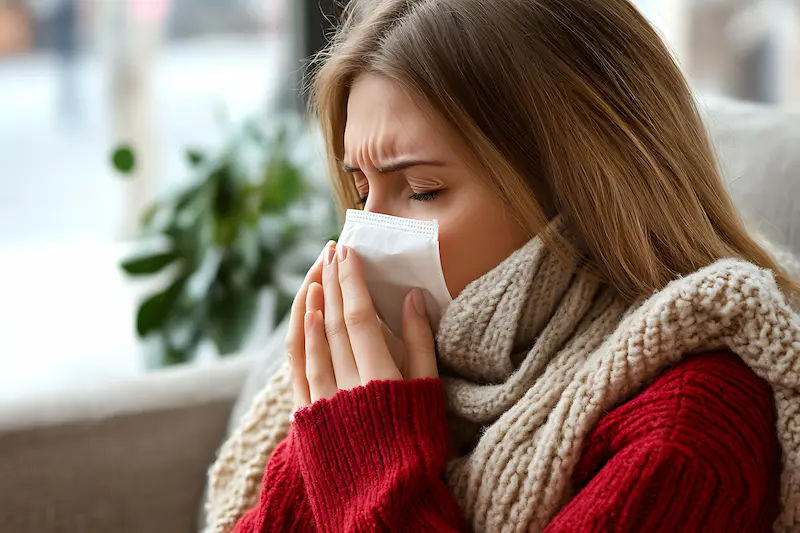Ways To Reduce Air Pollution And Its Bad Effects Dr Naveen Ailawadi
Discover practical steps you can take at home and in your community to reduce air pollution and protect your health. Learn how air pollution affects your body and find answers to common FAQs in this easy-to-read guide.

Written by Dr. Md Yusuf Shareef
Reviewed by Dr. Rohinipriyanka Pondugula MBBS
Last updated on 6th Oct, 2025

Introduction
Every breath we take is a testament to life, but what if the air itself is slowly harming us? The reality of modern living is that air pollution has become a pervasive and silent threat, contributing to millions of premature deaths worldwide. The term "bad air" often feels abstract, but its effects are concrete, impacting our health from our respiratory system to our cardiovascular health.
This article moves beyond just outlining the problems. We will delve into a practical, actionable guide to help you
understand the sources of pollution, mitigate your exposure, and contribute to cleaner air for everyone. By adopting
even a few of these strategies, you can take significant steps toward safeguarding your well-being and that of your
community. Let's clear the air, together.
Understanding the Enemy: What Makes Air Pollution So "Bad"?
Before we can fight it, we must understand it. Air pollution isn't a single substance but a complex mixture of harmful
particles and gases. Its "bad" reputation is well-earned, stemming from its ability to infiltrate our bodies and cause
widespread damage.
1. The Usual Suspects: Common Air Pollutants and Their Sources
The most dangerous pollutants are often invisible to the naked eye. Key culprits include:
- Particulate Matter (PM2.5 and PM10): These are tiny particles suspended in the air. PM2.5 particles are so small they
can penetrate deep into the lungs and even enter the bloodstream. Primary sources include vehicle exhaust, industrial
emissions, construction dust, and burning of fossil fuels and biomass. - Nitrogen Dioxide (NO₂): This reddish-brown gas is primarily emitted from vehicle engines and power plants. It irritates
the airways and is a major component of smog. - Sulphur Dioxide (SO₂): Produced from burning fossil fuels like coal at power plants and industrial facilities, SO2 can
lead to acid rain and respiratory illnesses. - Ground-Level Ozone (O₃): Unlike the protective ozone layer in the upper atmosphere, ground-level ozone is a harmful
pollutant formed by the reaction of sunlight with pollutants from vehicles and industries. It is a key trigger for asthma
and other lung diseases.
2. The Air Quality Index (AQI): Your Daily Pollution Report Card
The AQI is a crucial tool for the public. It transforms complex air quality data into a simple colour-coded scale (Good,
Moderate, Unhealthy for Sensitive Groups, Unhealthy, Very Unhealthy, Hazardous). Checking your local AQI,
available through weather apps or government websites, should be as routine as checking the weather forecast. On days
when the AQI is poor, you can take proactive steps to limit your exposure, such as reducing outdoor exercise or
wearing a protective mask (like an N95).
Consult Top Doctors for Your Symptoms
The Invisible Threat: How Bad Air Impacts Your Health
The health effects of PM2.5 and other pollutants are far-reaching. While everyone is affected, children, the elderly, and
individuals with pre-existing conditions are most vulnerable.
A. Short-Term Effects: From Coughs to Cardiac Stress
Exposure to high levels of pollution can cause immediate problems, including:
- Irritation of the eyes, nose, and throat
- Aggravation of existing conditions like asthma, bronchitis, and emphysema, leading to coughing, wheezing, and
shortness of breath - Increased risk of respiratory infections
- Extra stress on the heart and lungs, which can trigger cardiac events in susceptible individuals
B. Long-Term Risks: The Link to Chronic Disease and Reduced Lifespan
Chronic exposure to bad air quality is even more concerning. Studies have consistently linked long-term exposure to air
pollution with:
- Development of chronic respiratory diseases like COPD
- Increased risk of heart disease, heart attacks, and strokes
- Long-term impact on lungs, including reduced function and an increased risk of lung cancer
- Negative effects on the nervous system, potentially contributing to cognitive decline
- Complications during pregnancy and adverse effects on foetal development
Your Action Plan: 10 Ways to Reduce Air Pollution and Protect Your Health
The good news is that we are not powerless. Combating air pollution requires a combination of individual action and
collective advocacy. Here are ten effective strategies.
1. Rethink Your Ride: Sustainable Transportation Choices
Transportation is a major contributor to urban air pollution. You can make a difference by:
- Using Public Transport: Buses and trains move many people far more efficiently than individual cars.
- Carpooling: Sharing rides halves or quarters the number of vehicles on the road.
- Cycling or Walking: For short distances, these are zero-emission options that boost your health directly.
- Opting for Electric Vehicles (EVs): If you're in the market for a new car, consider an EV to eliminate tailpipe emissions.
- Smart Errands: Combine trips to avoid multiple short journeys, as cold engines pollute more.
2. Power Down: Energy Conservation at Home and Work
Reducing energy consumption directly cuts down on power plant emissions:
- Switch to LED light bulbs, which use up to 90% less energy than incandescent bulbs.
- Unplug electronics when not in use to avoid "vampire" energy drain.
- Use energy-efficient appliances.
- Support the shift to renewable energy sources like solar or wind power for your home or community.
3. Make Smarter Purchases: Supporting a Green Economy
Your wallet is a powerful tool. Choose products from companies with strong environmental commitments. Look for
items with minimal packaging, and avoid single-use plastics, whose production is a significant source of pollution.
4. Reduce, Reuse, Recycle: The Classic Trio with a Clean Air Bonus
Manufacturing new goods from raw materials is energy-intensive. By recycling and reusing, you reduce the demand for
manufacturing, which in turn reduces industrial emissions. Composting organic waste also prevents it from ending up in
landfills, where it can release methane, a potent greenhouse gas.
5. Advocate for Change: Using Your Voice for Cleaner Air Policies
Individual actions are vital, but systemic change is paramount. Support government policies to control air pollution,
such as stricter emissions standards for industries and vehicles, investment in public transport, and creation of green
spaces. Vote for leaders who prioritise environmental health.
Creating a Safe Haven: How to Improve Your Indoor Air Quality
We spend up to 90% of our time indoors, where air can be 2-5 times more polluted than outdoors. Protecting your
indoor space is critical.
A. The Power of Plants: Natural Air Purifiers
While not a complete solution, certain houseplants can help remove trace amounts of toxins. Consider adding plants for
indoor air purification like Spider Plants, Snake Plants, or Peace Lilies. They also add humidity and a sense of well-
being.
B. Smart Habits for a Healthier Home Environment
Creating a healthier indoor environment starts with simple, daily habits that reduce pollutants and improve the air you
breathe.
- Ventilate: Regularly open windows when the outdoor AQI is good to allow fresh air to circulate and flush out indoor
pollutants. - Avoid Indoor Smoking: This is one of the most significant sources of indoor air pollution.
- Use Exhaust Fans: Turn on kitchen and bathroom fans to remove moisture and contaminants directly at the source.
- Choose Low-VOC Products: Volatile Organic Compounds (VOCs) are emitted from paints, cleaners, and air fresheners.
Opt for natural or low-VOC alternatives. - Consider an Air Purifier: A HEPA-filter air purifier can effectively reduce particulate matter indoors, especially
beneficial for those with allergies or asthma.
Conclusion: A Collective Breath of Fresh Air
The challenge of air pollution can feel overwhelming, but the power to incite change lies in our collective daily choices.
By understanding what makes air pollution so bad and taking proactive steps, both big and small, we can significantly
reduce our personal exposure and our contribution to the problem. From choosing to cycle to work to advocating for cleaner energy, every action contributes to a larger solution. Clean air is not a luxury; it is a fundamental requirement
for health.
If you or a family member experience persistent respiratory issues like a chronic cough, wheezing, or shortness of breath
that you suspect may be linked to air quality, it is crucial to consult a healthcare professional. You can book an appointment online with a specialist on Apollo24|7 for a comprehensive evaluation. Let's commit to making the next breath we take, and every one after, a cleaner and healthier one.
Consult Top Pulmonologists
Consult Top Pulmonologists

Dr. Sumara Maqbool
Pulmonology Respiratory Medicine Specialist
12 Years • MBBS, DNB Respiratory, critical care and sleep medicine, DrNB superspeciality Critical care, IDCCM, IFCCM, EDIC
Delhi
Apollo Hospitals Indraprastha, Delhi
(25+ Patients)

Dr. K R R Umamahesh Reddy
Pulmonology Respiratory Medicine Specialist
9 Years • MBBS, MD Pul Med.
Nellore
Apollo Speciality Hospitals, Nellore
(25+ Patients)

Dr Rakesh Bilagi
Pulmonology Respiratory Medicine Specialist
10 Years • MBBS MD PULMONOLOGIST
Bengaluru
Apollo Clinic, JP nagar, Bengaluru
Dr. Sasikamalam
General Practitioner
1 Years • MBBS
COIMBATORE
Apollo Sugar Clinic Coimbatore, COIMBATORE

Dr. Amrutha G
General Physician/ Internal Medicine Specialist
10 Years • MBBS,DNB(family medicine), Diabetologist-CCEBDM,CCGDM
Bengaluru
Apollo Clinic, Sarjapur Road, Bengaluru
Consult Top Doctors for Your Symptoms

Dr. Sumara Maqbool
Pulmonology Respiratory Medicine Specialist
12 Years • MBBS, DNB Respiratory, critical care and sleep medicine, DrNB superspeciality Critical care, IDCCM, IFCCM, EDIC
Delhi
Apollo Hospitals Indraprastha, Delhi
(25+ Patients)

Dr. K R R Umamahesh Reddy
Pulmonology Respiratory Medicine Specialist
9 Years • MBBS, MD Pul Med.
Nellore
Apollo Speciality Hospitals, Nellore
(25+ Patients)

Dr Rakesh Bilagi
Pulmonology Respiratory Medicine Specialist
10 Years • MBBS MD PULMONOLOGIST
Bengaluru
Apollo Clinic, JP nagar, Bengaluru
Dr. Sasikamalam
General Practitioner
1 Years • MBBS
COIMBATORE
Apollo Sugar Clinic Coimbatore, COIMBATORE

Dr. Amrutha G
General Physician/ Internal Medicine Specialist
10 Years • MBBS,DNB(family medicine), Diabetologist-CCEBDM,CCGDM
Bengaluru
Apollo Clinic, Sarjapur Road, Bengaluru
More articles from respiratory-conditions
Frequently Asked Questions
Q1. What are the most common symptoms of bad air quality exposure?
Common symptoms include irritation of the eyes, nose, and throat, coughing, phlegm, chest tightness, and shortness of breath. People with asthma may experience more frequent attacks.
Q2. Can air pollution really cause heart disease?
Yes. Research shows that long-term exposure to fine particulate matter (PM2.5) can contribute to the buildup of plaque in arteries, increase blood pressure, and elevate the risk of heart attacks and strokes.
Q3. What is the difference between indoor and outdoor air pollution?
Outdoor pollution comes from sources like vehicles, industry, and dust. Indoor pollution originates from sources inside buildings, such as tobacco smoke, cooking fumes, cleaning products, mould, and VOCs from furniture and paints.
Q4. Are there any natural ways to help detoxify lungs from pollution?
While the lungs are self-cleaning organs, you can support their health by staying hydrated, which helps thin mucus, and consuming a diet rich in antioxidants, found in fruits and vegetables, to combat inflammation caused by pollutants. However, the most effective strategy is to reduce exposure.
Q5. What should I do on a day when the AQI is 'Unhealthy'?
Limit prolonged or heavy exertion outdoors. If you need to go outside, consider wearing a well-fitted N95 or KN95 mask. Keep windows closed and use an air purifier indoors. Reschedule intense outdoor workouts for a day when the air quality is better.

